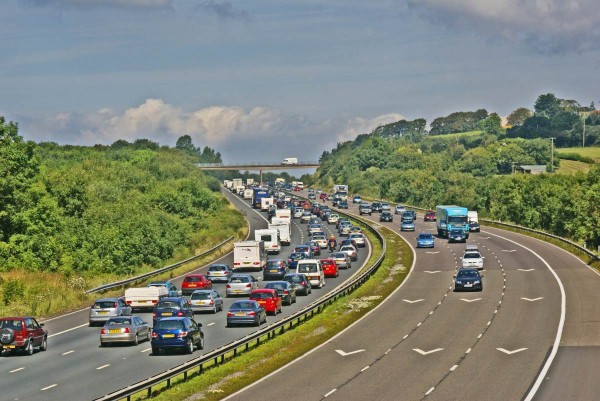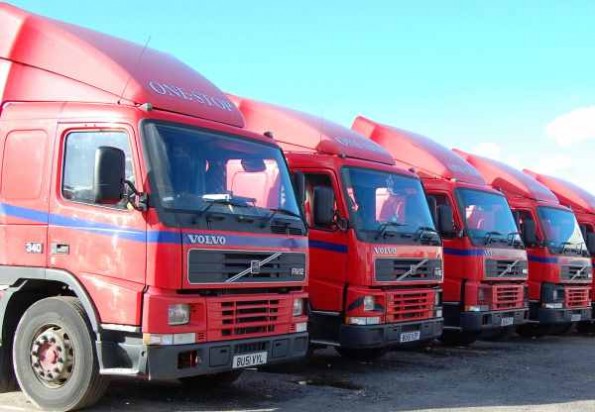Trucking is a cutthroat business with thin margins, so anything you can do to save fuel makes a big difference to the profitability of the company.
Don’t come to a stop unless absolutely necessary: acceleration, anticipation and braking sense
Getting your truck moving again after it stops uses much more fuel than going slower but maintaining some momentum. It’s better to vary the gap between you and the vehicle in front so that you can maintain even just a walking pace to keep some momentum going.
When coming up to traffic lights be looking well ahead so that you can anticipate when they are going to change. If they’re green now and you’re a fair way away, they’ll probably be red when you get there, so ease off the accelerator early and you’ll save your brakes, too. Just make sure you’re not unduly holding up other drivers. If they’ve been red for a while then you might be able to time your arrival with them going green, especially if you can get a glimpse of the lights that the other traffic is seeing (this is easier at night).
Gap selection at roundabouts means looking to time your roundabout arrival and entry when there’s a gap in the traffic. It means you can choose a shorter gap, whereas getting moving from a standstill requires a much longer gap in traffic for you to avoid causing other vehicles to brake.
Smooth cornering is where you’ll maintain more speed. Practice taking smooth lines, do all your braking on the straight and get into the right gear so that you can maximise your existing momentum as you exit the corner. Be careful of rollover accidents; the best rule of thumb is slow in and accelerate out. If you’re trail braking into anything but a decreasing-radius corner then you’ve probably left your braking a little late.

Traffic starts to back up on the motorway and truck drivers try to maintain their momentum
On motorways use your extra height to anticipate what’s happening ahead. Spread out the gap between you and the vehicle in front so that while they are stopping and starting you are maintaining a consistent speed. Sure, you’ll have car drivers dive in front of you, but the amount you’ll save on fuel more than makes up for the couple of minutes longer it will take you.
Allow your speed and momentum to build up naturally on downhill stretches and let it carry you on uphill stretches. Ease off the accelerator as you reach the crest of a hill.
Reduce the resistance to movement: aerodynamics, tyres and wheels
Aerodynamics
You’ve got a tall vehicle with a large surface area pushing through the air, but you can make it more aerodynamic. About 20% of your fuel consumption is taken up with overcoming air resistance. While this doesn’t apply so much in the city, at motorway speeds it’s a significant force – just stick your hand out of the window and see how much force there is against it, then multiple that up by the cross section of the front of your truck.
You can
- Add roof-top air deflectors bridge the jump in height from your cab to the trailer
- Add cab side edge turning vanes
- Install trailer front fairings and aerodynamic side skirts
- Move the trailer as far forward as possible if you have a sliding fifth-wheel coupling
- Use a front, under-bumper air dam
- Ensure you correctly sheet empty tipper bodies (this alone will save you about 8% in fuel consumption)
- Keep curtain-side trailers taught so they don’t flap in the wind
- Choose the lowest load height possible
- Arrange your load so it’s as aerodynamic as possible without exceeding axle weight limits
- Purchase a truck with an engine and gearbox ratios specifically adapted for your type of routes and driving (request a simulation from the dealer)
Repairing damaged fairings makes a difference as they disrupt the smooth flow of air. Use open windows rather than air conditioning.
Tyres
A 10psi fall in tyre pressure increases your fuel consumption by 1%. It also means the tyres degrade more quickly and are at greater risk of a blowout. When they’re under-inflated they squash down more on the road meaning more ‘rolling resistance’ (the energy it takes to turn them). Conversely, you don’t want to over-inflate them as this reduces your grip. Use the manufacturer’s recommended cold pressure inflation.
You can use low rolling resistance tyres if they are suitable for the type of driving you do and if it’s possible to lift wheels that aren’t in use, do so.
Wheels
If your wheels are not aligned the trailer with crab sideways, meaning it’s not as aerodynamic, and it doesn’t roll as easily. This creates extra fuel use and tyre wear.
You can also choose a tractor cab configuration with the best economy for your requirements. A 6×2 axle has one steering axle and two axles underneath the fifth-wheel, but only one of those axles is a drive axle; the other is a ‘dead axle’. This saves fuel because there are less moving parts than if you have two drive axles (6×4). Figures of 2-3% are quoted.
Use technology: cruise control, route planners and data loggers
Data collection
Collecting data about your trips lets you see patterns of use and where you can make improvements. You might find that fuel from a particular supplier doesn’t work as well in your lorry as fuel from another supplier. You could experiment with different routes and different times of the day. Fine tuning this data can have big payoffs, and it’s something that small operators are often unwilling to do, so it would make you more competitive. At minimum you should be tracking your average gallons per 100 miles (or litres per 100km) so that you can quickly detect if something is going wrong with the engine.
Use telematics to give you more detail. These track your trips and a lot of data about how the engine and brakes are used. You can identify types of driving where you could save money.
Trip scheduling
Use trip planning software to work out the most effective route and use a navigation system that reroutes you around holdups (or at least alerts you so that you can choose to take a break before you hit it, for example).
Try scheduling the same run at different times and working out which one was quickest; a 10-minute change in your start time could mean 15-20 minutes less time to do the whole run, and that usually means less fuel used due to less time on the road.
Check weather forecasts
Try to avoid driving when there will be holdups due to bad weather, or the weather itself is the holdup, e.g. fog or snow. You’ll use more auxiliary equipment when the weather is bad.
If it’s raining heavily and there’s a lot of standing water on the road, this creates extra resistance against your tyres. Try not to drive through long puddles if possible. Check the Met Office, or your preferred weather source.
Cruise control
Cruise control on good, flat roads with constant high speeds prevents you inadvertently moving your foot up and down which uses micro amounts of extra fuel for no gain. It also reduces your chances of getting a speeding ticket if your lorry doesn’t have a limiter.
Treat the engine and gearbox carefully
Keep your engine well-serviced and it will last you hundreds of thousands of miles. Try to avoid sitting with it idling unnecessarily. If you’re going to be stationary for any more than 30 seconds you can turn it off; it causes less pollution, too.
Warming up the engine
Take it easy while the engine is warming up. You could use up to 20% of your fuel in the first 10 minutes of the journey!
Revs
Keep your revs in the economical (green) band. If you don’t have a green band on your rev counter, contact your lorry’s manufacturer to ask them what the recommend rev band is for the best economy.
Skip gears
You don’t have to go up or down through every gear. Changing gear loses momentum and it wears the gearbox out. Block shifting is perfectly fine when possible, especially if you’re gaining speed going downhill.
Park up with care and caution

Lorries parked up and ready to drive away with minimal manoeuvring
Protect your fuel and your load when you park up. Fuel is expensive, so don’t make it easy for people to steal. When you park, position your lorry so that you can simply drive away for your next run. You want to try to avoid doing lots of manoeuvres on a cold engine as this is when the most fuel is used.
Reduce the load
Don’t carry unnecessary equipment or loads in your lorry. Every bit of weight counts. Every 5000kg of load worsens your fuel economy by about 5%.
